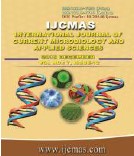


 National Academy of Agricultural Sciences (NAAS)
National Academy of Agricultural Sciences (NAAS)

|
PRINT ISSN : 2319-7692
Online ISSN : 2319-7706 Issues : 12 per year Publisher : Excellent Publishers Email : editorijcmas@gmail.com / submit@ijcmas.com Editor-in-chief: Dr.M.Prakash Index Copernicus ICV 2018: 95.39 NAAS RATING 2020: 5.38 |
A research work to study the richness of arthropod diversity under short duration pigeonpea intercropping systems was carried out at Agricultural Research Farm of Banaras Hindu University, Varanasi (UP). The faunal composition of insect pests associated with short duration pigeonpea intercropping systems in kharif 2004 and 2005 was of eight orders viz., Orthoptera, Homoptera, Thysanoptera, Lepidoptera, Diptera, Hymenoptera and Coleoptera. One bird pest of order Psittaciformes was also recorded. The twenty species of insect pests and one bird pest species were recorded infesting short duration pigeonpea under intercropping systems. The insect pests observed at vegetative and reproductive stages of the crop growth were green jassid, tur pod bug, green stink bug, gram pod borer and blue butterfly. The remaining insect pests were active either at vegetative or reproductive stage of the crop. The rose ringed parakeet was observed feeding pods at reproductive stage of crop growth. The relative abundance in the pigeonpea + sorghum (T1) treatment plot was highest in case of flower thrips (M. usitatus) and lowest in case of green stink bug. In sole crop of pigeonpea higher relative abundance was recorded by scale insects and lower by leaf cutter bees. Among all insect pests and in all treatments flower thrips had highest relative abundance and green stink bug had recorded lowest relative abundance during both the years of experimentation. The relative abundance of insect pests was very much low in pigeonpea + sorghum and highest in sole crop of pigeonpea. The average of two years data on the extent of pod damage by gram pod borer showed that pod damage (%) was more in sole crop of pigeonpea (T7) while less in pigeonpea + sorghum (T1). The data on pod damage (%) by tur pod fly recorded during both the years was pooled to know the overall effect of intercropping on pod damage (%) and it was found that pod damage (%) was significantly reduced in pigeonpea + sorghum (T1) than in other treatments. Seed damage (%) due to gram pod borer and pod fly was more in pigeonpea grown alone while it was less in the intercrops pigeonpea + sorghum (T1).
 |
 |
 |
 |
 |